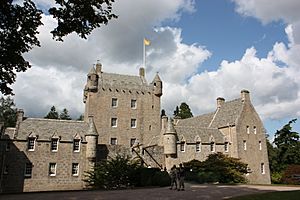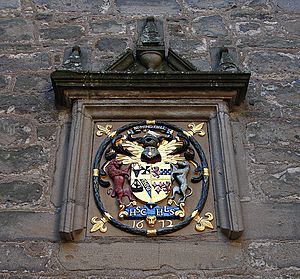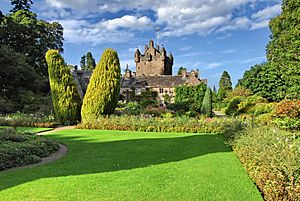Cawdor Castle facts for kids
Quick facts for kids Cawdor Castle |
|
|---|---|

Cawdor Castle from the east
|
|
|
Listed Building – Category A
|
|
| Designated | 26 January 1971 |
| Reference no. | LB1728 |
|
Inventory of Gardens and Designed Landscapes in Scotland
|
|
| Designated | 1 July 1987 |
| Reference no. | GDL00099 |
| Lua error in Module:Location_map at line 420: attempt to index field 'wikibase' (a nil value). | |
Cawdor Castle is a famous old castle located in Nairnshire, Scotland. It was first built around a strong tower house in the 1400s, and more parts were added over many years.
The castle originally belonged to the Calder family. In the 1500s, it became the property of the Campbell family. The Campbells still own the castle today. It is currently home to Angelika Campbell, Dowager Countess Cawdor.
Many people know Cawdor Castle because of William Shakespeare's play Macbeth. In the play, the main character is called "Thane of Cawdor". However, the play is a fictional story. The castle itself was built long after the real King Macbeth lived in the 11th century. The play does not even mention the castle directly.
Cawdor Castle is a very important historical building in Scotland. Its beautiful grounds are also listed as significant gardens.
Contents
History of Cawdor Castle
The earliest official record for Cawdor Castle is from 1454. This is when William Calder, the 6th Thane of Cawdor, was given permission to build a fortified home. However, some parts of the castle's oldest tower might be even older. Experts believe the stonework in the oldest section dates back to about 1380.
The Holly Tree Story
One interesting thing about the castle is that it was built around a small, living holly tree. A local story says that a donkey carrying gold lay down to rest under this tree. This spot was then chosen as the perfect place to build the castle. You can still see the remains of this ancient tree in the lowest part of the tower. Scientists have studied the tree and found that it died around 1372. This supports the idea that the castle's first parts were built even earlier than 1454.
The iron gate, called a "yett," at Cawdor Castle came from Lochindorb Castle. King James II ordered Lochindorb Castle to be taken apart around 1455. William Calder then brought its gate to Cawdor.
Castle Expansions Over Time
Cawdor Castle was made bigger many times over the centuries. In 1510, Muriel, who inherited the castle from the Calders, married Sir John Campbell. He started adding more parts to the castle. Their children included Katherine Campbell, Countess of Crawford.
More improvements were made by John Campbell, 3rd of Cawdor. By 1635, a garden had been added to the castle grounds. After the Scottish Restoration, Sir Hugh Campbell of Cawdor added or improved the north and west parts of the castle. He hired skilled builders named James and Robert Nicolson for this work.
The Campbell Family and Cawdor
In the 1680s, Sir Alexander Campbell met and married Elizabeth Lort. After this, the Campbell family of Cawdor mostly lived on their estates in Pembrokeshire, Wales. Younger brothers of the family stayed at Cawdor to manage the estates. They built a walled flower garden in 1720. They also planted many trees in the late 1700s, creating large woodlands.
John Campbell, 1st Baron Cawdor, who was a Member of Parliament, became Lord Cawdor in 1796. His son later became the first Earl Cawdor in 1827. During the 1800s, the Earls used Cawdor as a summer home. Architects Thomas Mackenzie and Alexander Ross added the southern and eastern parts of the castle. This created a courtyard that could be reached by a drawbridge.
In the 1900s, John Campbell, 5th Earl Cawdor, moved to Cawdor permanently. His second son, James Campbell (potter), was born there. The 5th Earl was followed by the 6th Earl. The 6th Earl's second wife, Dowager Countess Angelika, still lives at the castle today.
Cawdor Castle Gardens
Cawdor Castle is famous for its beautiful gardens. These include:
- The Walled Garden: This garden was first planted in the 1600s.
- The Flower Garden: This garden was created in the 1700s.
- The Wild Garden: This garden was added in the 1960s.
The castle grounds also have a large wood. This wood is home to many different kinds of trees. It also has over 100 types of lichen, which are small plant-like growths.
Cawdor and Shakespeare's Macbeth
The name Cawdor is still linked to William Shakespeare's famous play Macbeth. However, the story in Shakespeare's play is very different from real history.
The real King Macbeth ruled Scotland from 1040 to 1057. His forces defeated King Duncan I in battle. The real Macbeth was never called "Thane of Cawdor." This title was made up by a writer named Hector Boece in the 1400s.
Also, Cawdor Castle did not even exist when Macbeth or Duncan were alive. The play never directly mentions the castle. The 5th Earl Cawdor once said, "I wish the Bard had never written his damned play!" This shows how much the castle's real history differs from the play.
See also
 In Spanish: Castillo Cawdor para niños
In Spanish: Castillo Cawdor para niños




